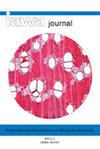无射线和幼体形成:木质部射线在从原形成层到维管形成层的过程中的损失和获得
IF 3.5
3区 农林科学
Q2 FORESTRY
引用次数: 1
摘要
Carlquist工作的一个反复出现的主题是识别被子植物初级木质部的典型特征,但在某些物种的次级木质部中发现。这些特征共同构成了“卡尔奎斯特综合征”。该综合征在具有相似习性的植物中的集中发生表明了其适应价值。它的一个组成部分——无射线——受到了最多的关注,并被认为是有利于茎刚性的选择的结果。然而,很少有人研究无射线(或一般的卡奎斯特综合征)是如何在个体遗传学上产生的。在这里,我们报道了在一些植物中,次生木质部类似于同一个体的初级木质部,而不是像Carlquist所观察到的一般被子植物的木质部。根据文献和微滑动调查,我们在非单子叶被子植物的大多数主要分支中,包括木兰、紫苑和蔷薇中,确定了初级木质部模式向次级木质部的延长。本文章由计算机程序翻译,如有差异,请以英文原文为准。
Raylessness and paedomorphosis: losses and gains of xylem rays en route from procambium to vascular cambium
A recurring motif of Carlquist’s work is the identification of traits typical for primary xylem of angiosperms as a whole, but found in the secondary xylem of certain species. These traits together make up the ‘Carlquistian syndrome’. Convergent occurrence of the syndrome in plants with similar habits suggests its adaptive value. One of its components — raylessness — has received the most attention and has been regarded as the result of selection favouring stem rigidity. However, how raylessness (or the Carlquistian syndrome in general) arises ontogenetically has been little studied. Here, we report that in some plants secondary xylem resembles primary xylem of the same individual, and not that of angiosperms in general as observed by Carlquist. Based on literature and microslide surveys, we identified this prolongation of primary xylem patterns into secondary xylem in most major clades of non-monocot angiosperms, including magnoliids, asterids and rosids.
求助全文
通过发布文献求助,成功后即可免费获取论文全文。
去求助
来源期刊

IAWA Journal
农林科学-林学
CiteScore
3.40
自引率
15.80%
发文量
26
审稿时长
>36 weeks
期刊介绍:
The IAWA Journal is the only international periodical fully devoted to structure, function, identification and utilisation of wood and bark in trees, shrubs, lianas, palms, bamboo and herbs. Many papers are of a multidisciplinary nature, linking
 求助内容:
求助内容: 应助结果提醒方式:
应助结果提醒方式:


